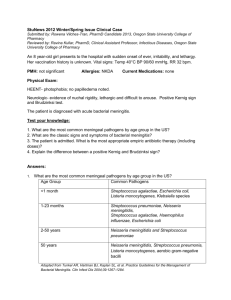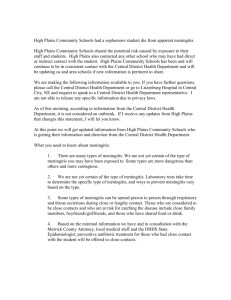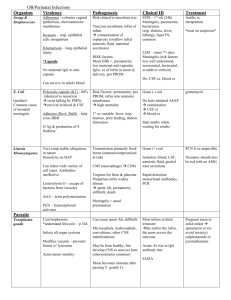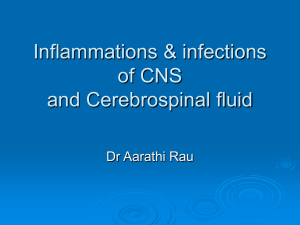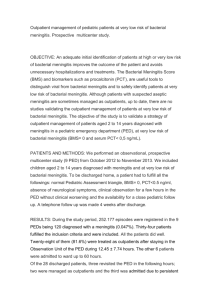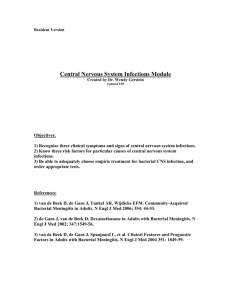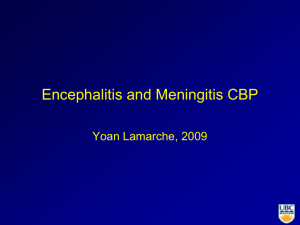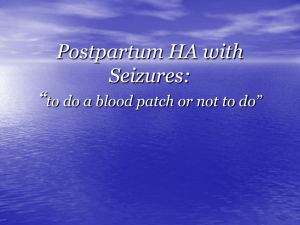PDF - EA
advertisement
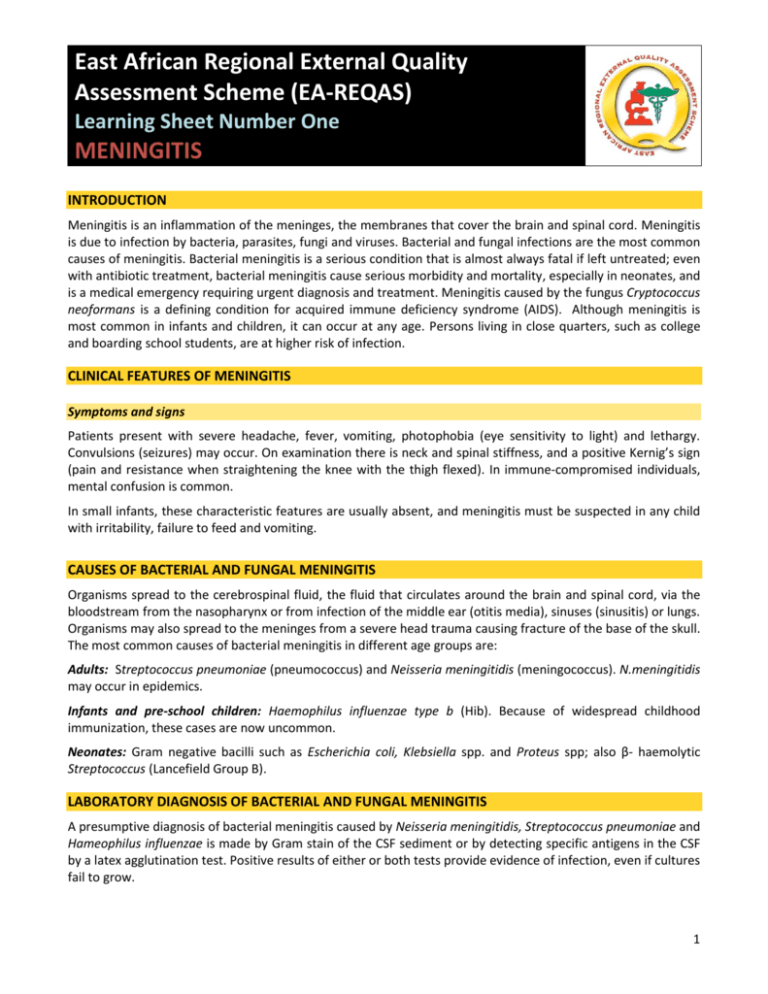
East African Regional External Quality Assessment Scheme (EA-REQAS) Learning Sheet Number One MENINGITIS INTRODUCTION Meningitis is an inflammation of the meninges, the membranes that cover the brain and spinal cord. Meningitis is due to infection by bacteria, parasites, fungi and viruses. Bacterial and fungal infections are the most common causes of meningitis. Bacterial meningitis is a serious condition that is almost always fatal if left untreated; even with antibiotic treatment, bacterial meningitis cause serious morbidity and mortality, especially in neonates, and is a medical emergency requiring urgent diagnosis and treatment. Meningitis caused by the fungus Cryptococcus neoformans is a defining condition for acquired immune deficiency syndrome (AIDS). Although meningitis is most common in infants and children, it can occur at any age. Persons living in close quarters, such as college and boarding school students, are at higher risk of infection. CLINICAL FEATURES OF MENINGITIS Symptoms and signs Patients present with severe headache, fever, vomiting, photophobia (eye sensitivity to light) and lethargy. Convulsions (seizures) may occur. On examination there is neck and spinal stiffness, and a positive Kernig’s sign (pain and resistance when straightening the knee with the thigh flexed). In immune-compromised individuals, mental confusion is common. In small infants, these characteristic features are usually absent, and meningitis must be suspected in any child with irritability, failure to feed and vomiting. CAUSES OF BACTERIAL AND FUNGAL MENINGITIS Organisms spread to the cerebrospinal fluid, the fluid that circulates around the brain and spinal cord, via the bloodstream from the nasopharynx or from infection of the middle ear (otitis media), sinuses (sinusitis) or lungs. Organisms may also spread to the meninges from a severe head trauma causing fracture of the base of the skull. The most common causes of bacterial meningitis in different age groups are: Adults: Streptococcus pneumoniae (pneumococcus) and Neisseria meningitidis (meningococcus). N.meningitidis may occur in epidemics. Infants and pre-school children: Haemophilus influenzae type b (Hib). Because of widespread childhood immunization, these cases are now uncommon. Neonates: Gram negative bacilli such as Escherichia coli, Klebsiella spp. and Proteus spp; also β- haemolytic Streptococcus (Lancefield Group B). LABORATORY DIAGNOSIS OF BACTERIAL AND FUNGAL MENINGITIS A presumptive diagnosis of bacterial meningitis caused by Neisseria meningitidis, Streptococcus pneumoniae and Hameophilus influenzae is made by Gram stain of the CSF sediment or by detecting specific antigens in the CSF by a latex agglutination test. Positive results of either or both tests provide evidence of infection, even if cultures fail to grow. 1 East African Regional External Quality Assessment Scheme (EA-REQAS) Learning Sheet Number One MENINGITIS The diagnosis of fungal infection caused by Cryptococcus neoformans is made by detecting capsulated yeasts in India Ink preparations of CSF. Specimens for examination The most important specimen is cerebrospinal fluid (CSF) which should be collected before antibiotic treatment is started. CSF is collected by performing a lumbar puncture. Collect 2 – 3 ml of CSF using an aseptic technique and place in 2 sterile leak-proof, screw-capped containers. Blood may also be taken for culture for bacterial organisms. Procedure for performing a lumbar puncture A lumbar puncture is performed to collect samples of cerebrospinal fluid (CSF) in patients with suspected meningitis. Lumbar puncture should not be performed if there is a possibility of raised intracranial pressure, for example, a brain tumour, due to the danger of sudden death from “coning” of the medulla of the brain through the foramen magnum of the skull. Lumbar puncture should also not be performed in the presence of coagulation disorders, or if there is local infection near the puncture site. CSF is most conveniently collected by passing a needle into the spinal canal (subarachnoid space) surrounding the lower part of the spinal cord. For details of the procedure for collecting CSF see “Standard Operating Procedures for Laboratory Utilisation by Clinicians, SOP: 29”. Testing of CSF The following basic tests are performed on CSF in the peripheral laboratory (see “Standard Operating Procedures for Essential Laboratory Tests, SOP: 38”): 1. Total white cell count using a manual technique (Neubauer chamber) 2. Romanowsky stain (Giemsa stain, Field stain)to determine the predominant type of white cells present (neutrophils or lymphocytes) 3. Gram stain to determine the predominant type of bacteria present 4. Ziehl Neelsen stain for AFB to detect mycobacterial infection 5. India Ink stain to detect capsulated yeasts (C. neoformans) Presumptive diagnosis of causes of bacterial and fungal infections based on Gram stain N. meningitidis appears as Gram-negative (pink), coffee-bean shaped diplococci and may occur intracellularly (within polymorphonuclear leukocytes) or extra-cellularly. S. pneumoniae are characteristically round or ovoid in shape but may be lancet shaped. Gram-positive diplococci sometimes occur in short chains. H. influenzae are small, pleomorphic (varying shaped) Gram-negative rods or coccobacilli with a random arrangement. C. neoformans appear as capsulated yeasts (a clear halo around the yeast cell) in India Ink preparations. 2 East African Regional External Quality Assessment Scheme (EA-REQAS) Learning Sheet Number One MENINGITIS N. meningitidis S. pneumoniae H. influenzae C. neoformans Latex agglutination tests These tests are commercially available kits containing latex beads coated with antibody to the specific antigen to be detected. Kits to detect the most common organisms are available, including Neisseria meningitis, Streptococcus pneumoniae and Cryptococcus neoformans. Carefully follow the manufacturer’s instructions when using these test kits. For best results, test the supernatant of the centrifuged CSF sample as soon as possible. If immediate testing is not possible, refrigerate the sample (2 – 8°C) up to several hours, or freeze (-20°C) for longer periods. Reagents should be kept refrigerated when not in use. Product deterioration occurs at higher temperatures, especially in tropical climates, and test results may become unreliable before the expiry date of the kit. Latex suspensions should never be frozen. Transportation of CSF for further testing Transportation of CSF samples for culture is a difficult task because during shipping the specimens must be kept at body temperature (37oC). Specimens for isolation of Neisseria meningitidis, Haemophilus influenzae or Streptococcus pneumoniae must never be refrigerated because these pathogens are killed at low temperatures. Pack specimen bottles in absorbent padding to prevent breakage and absorb any leakage. Place in a carton box at room temperature – NOT IN A COOL BOX – and deliver to the reference laboratory within 24 hours from the time of specimen collection. Include one or two fixed, unstained slides placed in a slide carrier, and include the report from the field laboratory. TREATMENT OF BACTERIAL AND FUNGAL MENINGITIS Treatment of bacterial meningitis is a medical emergency and must be instituted without delay, preferably within one hour of the patient’s presentation to the clinic, to save lives and prevent neurological damage. Early treatment is the key to a good outcome. Treatment requires use of intravenous antibiotics as well as supportive therapy. Initially antibiotics addressing all major causes are instituted which are adjusted when results of culture and susceptibility testing are obtained and the specific causative organism has been confirmed. BIBLIOGRAPHY Popovic T., Ajello G., Facklam R., Laboratory methods for the diagnosis of meningitis caused by Neisseria meningitides, Streptococcus pneumoniae, and Haemophilus influenzae. WHO/CDS/CSR/EDC/99.7 Materu S, Dena R, Carter J (2014). Guidelines on specimen collection, storage and transportation. AMREF Health Africa. 3
